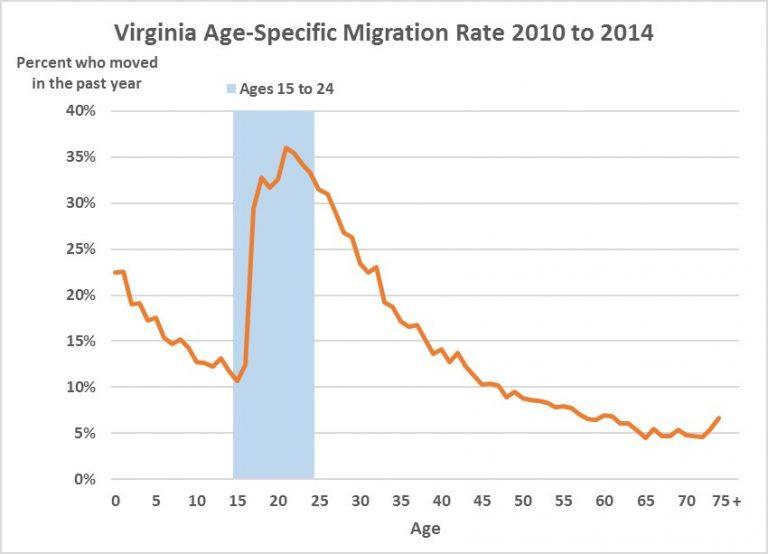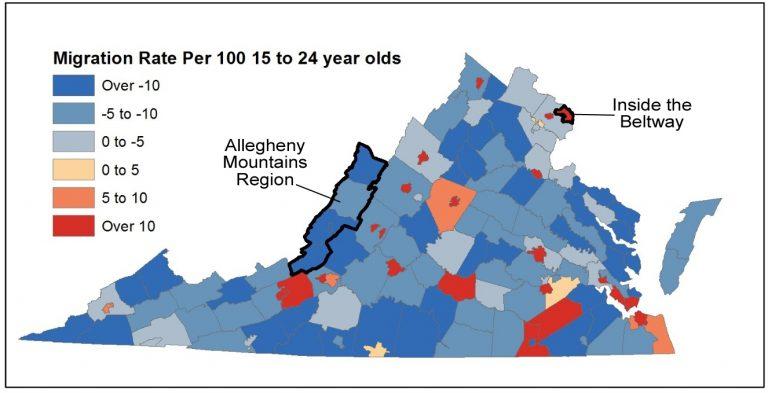Young adult migration trends in Virginia
No other age group experiences as much change within such as short period of time as young adults do. Until around age 18, the vast majority of children live with family and attend school. But then a great dispersion takes place, many young adults move away to attend college (69 percent of 2015 high school graduates enrolled in college), young adults will also often move to work in their first full-time jobs. Between 15 and 24, nearly 30 percent of Virginia’s young adults move in any given year, in comparison, after age 45 less than 10 percent of adults move annually. In Virginia, some localities attract more young adults than others, likewise, some localities lose more of their young adults than others.

Recently released census age estimates show that so far this decade some of Virginia’ cities and counties with universities are experiencing an influx of 15 to 24 year olds, but most of Virginia’s counties are experiencing a significant outflow of their 15 to 24 year old population. Between 2010 and 2015, 88 of Virginia’s 95 counties had more 15- to 24-year-olds move out than in, this is up from 69 counties between 2000 and 2005. Out-migration was largest in rural counties. In contrast, Virginia’s cities and counties with universities received a large inflow of 15- to 24-year-olds, with 24 of Virginia’s 38 independent cities experiencing an increase in their 15 to 24 year population from in-migration.
2010 to 2015

Compared with the last decade, the rate of out-migration has risen in most rural localities in Virginia. Between 2000 and 2005, localities outside Virginia’s metro areas experienced a 6.8 percent decline in their 15 to 24 year old population from out-migration. In the first five years of this decade, the out-migration of 15- to 24-year-olds from Virginia’s non-metro localities increased to 9.4 percent.

Among the localities situated in Virginia’s Allegheny Mountains, the out-migration rate of their 15 to 24 year old population rose from 7.1 percent between 2000 and 2005 to 12 percent in the last five years. The loss of so much of rural localities’ young population in recent decades is transforming the age distribution of their communities. In the Allegheny Mountain Region, the out-migration of young adults has caused the 18- to 29-year-old portion of the population to shrink to only 12 percent compared to 17 percent statewide. Similarly, the 30 to 39-year-old age group now makes up 9 percent of the region’s population compared to 14 percent statewide. With fewer young adults to start families, the under age 18 portion of the region’s population has in turn declined to well below the statewide proportion.

Many of Virginia’s urban areas and communities with universities are experiencing the opposite trend. Among Virginia’s localities inside the Washington Capital Beltway, the in-migration of 15- to 24-year-olds has caused their young adult share of the population to become larger than statewide rates. Alexandria City and Arlington County have the largest proportions of adults in their 30s in Virginia at 23 and 22 percent respectively. Even in localities outside large urban areas that have a university, such as Montgomery County, former students often remain in the community boosting the size of their workforce as well.
The rise in college attendance rates and the common need to move to large urban centers for graduates to find jobs are both likely helping drive the increasing flow of young adults into Virginia’s urban areas and communities with universities. The inflow of young adults into Virginia’s cities has boosted their workforce noticeably and helped support the revival in growth that many cities in Virginia are experiencing. But as an increasing share of young adults have remained in cities after starting families, it has also forced many urban localities, such as Arlington and Falls Church, to reevaluate their long-term planning as demand for housing and school spaces have surged.
In rural counties, the rise in out-migration of young adults is an intensification of a decades old trend. But the net effect of out-migration has been the hollowing out of many rural communities’ workforce, such as in the Allegheny Mountains Region. A smaller working age population has typically also meant fewer families with children in rural counties, often slowing population growth and in many cases causing population decline.
If all this sounds a bit gloomy for rural counties, keep in mind that the large majority are still attracting more people than they are losing, and in many cases their populations are growing. While nearly every rural county is losing a large portion of their young population, most are attracting an even larger number of older people, including retirees. Many of the older people that rural counties are attracting are likely the same ones that moved away for college or work decades ago.


